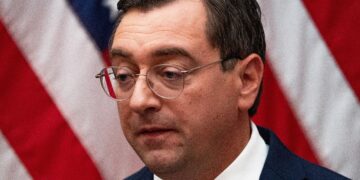Despite constant pressure from the White House, the Fed is keeping its key rates unchanged. While uncertainty seems less pronounced than a few weeks ago, visibility remains limited. The Fed expects tariffs to affect inflation in the coming months. But the extent of the shock to prices will depend on who bears the cost.
As expected, the Federal Reserve kept its key rates unchanged yesterday (in a range between 4.25% and 4.50%), while the new economic forecasts point to slightly higher inflation and slightly weaker growth for 2025.
Compared with March’s projections, growth has been revised down from 1.7% to 1.4%, inflation from 2.7% to 3% and the unemployment rate up a notch from 4.4% to 4.5%.
“Uncertainty about the economic outlook has diminished but remains high.” This is the main change in Jerome Powell’s speech compared to the last meeting. Uncertainty was the keyword of the press conference – mentioned 19 times – according to the count by MarketScreener’s macro research teams.
What the Fed is telling us is that we don’t really know what’s going to happen, but we think it will be not as bad as we thought six weeks ago.
Trade tensions have eased significantly in recent weeks. However, nobody really knows what the final tariffs will be, or even when negotiations will be concluded.
Hence the Fed chairman’s consistent stance: “We are well positioned to wait for more information on the likely path of the economy before considering any adjustment to our policy.”
Despite everything, Jerome Powell’s speech was perceived as slightly hawkish, with less emphasis on employment and risks to growth. Similarly, while the Fed members’ projections still show a median of two rate cuts in 2025, more members (7 out of 19, compared with 4 out of 19 in March) believe that rates will remain at their current levels this year.
On Wall Street, equity indices erased the gains accumulated earlier in the session to end pretty flat.
Who will pay the tariffs?
The difficulty for the Fed is that it expects more inflation in the coming months. This was mentioned in the latest Beige Book: “Many contacts reported faster increases in costs and prices. Some districts characterized these expected cost increases as strong, significant, or substantial.”
But as Jerome Powell himself acknowledged last night, the actual extent of price increases for consumers is still difficult to predict: “There is the manufacturer, the exporter, the importer, the retailer, and the consumer. Each of them will try not to be the one who pays the tariffs, but together they will pay together, or perhaps one party will pay the whole amount.”
One thing is certain at this stage: if the Fed is forced to remain on hold for longer, pressure from the White House will increase. Yesterday, from the White House gardens, a few hours before the Fed’s decision, Donald Trump was already saying, in his usual style: “Maybe I should be at the Fed. Am I allowed to appoint myself? I do a better job than these people. (…) So, whatever, we should be two points lower.”
Meanwhile, Jerome Powell had fun playing Donald Trump last night. When asked about the timing of rate cuts, he replied: “It could happen quickly. It might not happen quickly.”
The markets are still anticipating two 25-basis-point rate cuts between now and the end of 2025, with the first move coming in September.















